Looking for a way to keep your doggo in your yard without installing a physical fence?
Well, an electronic or “invisible” dog fence may be just the solution.
We’ll explain how these tools work and outline the basics of training your dog to use one, below. But we’ll also share our philosophical thoughts about these types of electric fences, including the reasons we now encourage owners to use alternatives in most cases.
Let’s jump right in!
Best Static Shock Dog Fences: Quick Picks
- #1 PetSafe Wireless Fence. [Most Reliable Invisible Fence]: An affordable wireless fence that emits a radio signal boundary to cover a circular range of up to 1/2 acre. It provides five levels of correction, including a sound-only mode, it is also portable and very easy to set up.
- #2 SpotOn Virtual Fence [Easiest Invisible Fence to Install]: This cutting-edge, tech-packed containment system uses no radio signal or wires, instead relying on GPS networks to keep your canine safe. You can customize your boundary completely for up to 1,000 acres, and it requires no digging or burying wires. It also offers a shock-free mode for those uncomfortable with aversive corrections.
- #3 YardMax Rechargeable Unit [Best Invisible Fence That Provides Extra Space]: This completely customizable in-ground fence allows you to cover a 1/2 acre of containment with the wire included, or buy additional wire to cover an area as large as 10 acres. Several correction levels are offered, as well as the option for additional collars for multiple pets. Collars are also rechargeable to save on batteries!
K9 of Mine has changed our position on using aversive tools like electronic fences and shock collars. We suggest all owners opt for physical barriers whenever possible — jump down to our section on “Are Electric Fences Cruel?” for more info.
What is an Invisible Dog Fence, and Why Do Some Owners Use Them?
Electric dog fences are dog containment systems that discourage your dog from leaving a pre-determined portion of your yard.
Also called “invisible,” hidden, or underground fences, these devices are designed to keep your dog from wandering or running away.
Some owners prefer wireless or in-ground dog fences to standard physical fences because they:
- Are easier to maintain. Electric dog fences are much easier to maintain than physical, above ground fences — you don’t have to paint them every few years or repair gaps or holes as they develop.
- Provide fewer ways for dogs to escape. Dogs cannot dig under or tear through wireless or under-ground fences, as they can with traditional physical fences or outdoor dog kennels.
- Preserve your outdoor view. Installing an electric dog fence allows owners to maintain their picturesque scenery, without having their view blocked by a physical fence or outdoor dog kennel.
- Are less expensive than physical fencing. Installing a physical yard fence can easily cost thousands of dollars, while wireless or in-ground hidden fences cost a fraction of that amount.
How Do Electric Dog Fences Work?
With all electric dog fence units, your dog will wear a special collar that communicates with your property’s boundary perimeter (which are established via a buried wire or a wireless signal).
When your dog first begins to approach the boundary line, the collar will emit a warning sound.
If your dog continues to approach the boundary and does not turn back within several seconds, the collar emits a static shock correction.
Technically, the term “invisible fence” should only be applied to containment systems sold by the company of the same name. However, the term “invisible fence” is often used generically, just like the words Q-Tip, Ketchup, and Xerox.
We’ll talk specifically about fences made by the Invisible Fence brand below, but we’ll also use the term more generically to refer to other types of “invisible” fence.
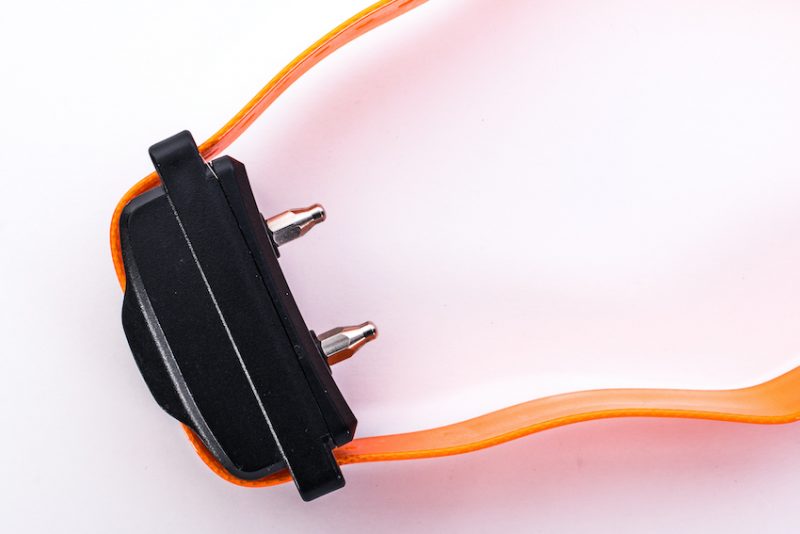
Types of Electric Dog Fence: Wireless vs In-Ground
There are two types of electric dog fences: wireless and wired (underground). Both types are hidden and can’t be seen by people or pets, but they function slightly differently.
Wireless Electric Dog Fences
Wireless transmitter dog fences use GPS or radio signals to establish a virtual yard perimeter and communicate with a corresponding dog collar to prevent your dog from traveling outside of the pre-determined boundary.
Some of the benefits and drawbacks of wireless dog fences include:
Pros
- They’re easy to install and require no digging or complicated installation
- The included base units are often portable
- You can adjust the boundary lines as necessary
- You can have one up and running in an hour or two
Cons
- In some cases, your established boundaries may fluctuate to a small degree
- Some units are affected by radio signals
- Some systems can only establish round perimeter shapes
Wired, Underground Dog Fences
With underground fences, a trench is dug along the property line (or wherever you’d like to establish the boundary), and then a length of wire is placed in the hole. The main transmitter unit connects with the physical wire perimeter, which then communicates boundary information to the dog’s collar.
As with wireless fences, there are pros and cons to hard-wired fences, including:
Pros
- The perimeter can be completely customized to any shape.
- The established perimeter won’t fluctuate
- Things like interference are rarely a problem
- Typically more reliable than wireless systems
Cons
- Complex installation that potentially requires a professional
- A trench must be dug around your yard
- They’re not portable
- Wire breaks can be frustrating to repair
7 Best Invisible Dog Fence: Underground and Wireless Static Shock Units
Now that you understand what invisible dog fences are, and how the various types differ, we can move on to some of our favorites!
We will be detailing several different product options from both PetSafe and Invisible Fence, the two biggest brand names in electric dog fences.
1. PetSafe Wireless System
About: The PetSafe Wireless Dog Fence System consists of a main transmitter unit that communicates with the corresponding dog collar.
The transmitter emits a 17.5 kHz radio signal that establishes a circular perimeter around your home. When your dog (wearing the receiver collar unit) nears the perimeter, he will hear a series of audible warning signals, followed by a static correction.
This is a sponsored placement, in which an advertiser pays a fee to be featured in this article. Learn more
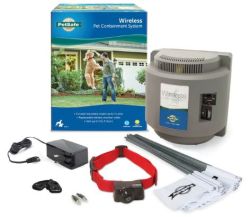
PetSafe Wireless System
A wireless, above-ground electric fence that provides up to 1/2 acre of coverage.
Key Features:
- Fully Adjustable Circular Perimeter: The 17.5 kHz radio signal creates a circular perimeter that is completely adjustable. It can establish a perimeter with a 90-foot radius all directions (resulting in a total possible diameter of 180 feet or ½ acre). You can position the transmitter to give your dog run of the front and back yard, or just one area.
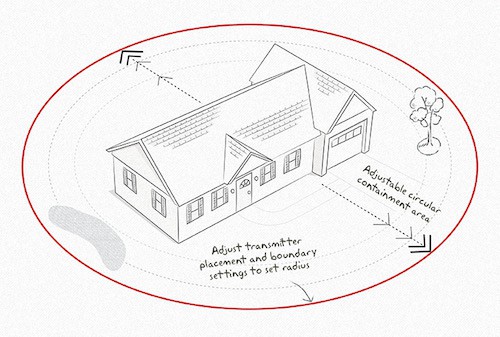
- Easy to Install: Just turn on the main transmitter unit, adjust your circular diameter range, and you’re set. No wires, no digging, no fuss.
- Adjustable Correction Options: Choose from five different correction levels (bigger dogs may need stronger static corrections). You can even set the unit up to trigger a sound-only correction if you like.
- Waterproof: The receiver collar is waterproof, so no need to keep your dog inside when it’s raining.
- Automatic Shut-Off: If your dog does end up leaving the boundary zone, the static correction will shut off after 30 seconds. It won’t activate again for another 5 minutes.
- Connect Multiple Yards: With multiple transmitters, you can actually connect several yards together, allowing dog neighbors to join together for even more safe play space for their pets! The two circle boundaries will overlap where they connect, joining the two areas together.
- Portable System: If you end up moving, you can easily take the PetSafe wireless dog fence system with you. Just unplug the central unit, grab the receiver collars, and your off (although you’ll have to re-train your dog to help him understand new boundaries).
- Works with Multiple Dogs: Use this wireless pet containment system with multiple dogs – simply buy multiple collars.
- Rated for Dogs Weighing 8 Pounds or More: This unit is designed for pets that weight 8 pounds or more.
Pros
- No digging or wires required
- The unit is portable
- Perimeter diameter is adjustable
- Comes with training protocol instructions
- YouTube training videos from the manufacturer are available
Cons
- Only provides a round perimeter area — you can’t make the perimeter square or rectangular
- Some owners report that the boundaries are inconsistent
- Electronic devices may trigger the collar
I have used the system with my own dog and feel like it generally worked quite well.
My one recommendation is to take off the collar once your dog enters the house. I found that some electronic devices in my home would set off the collar if my dog got too close to them, so I definitely recommend getting into the habit of removing the collar when your dog is in the home.
2. The SpotOn Virtual Smart Fence
About: The SpotOn Smart Fence is a virtual barrier that utilizes GPS technology rather than buried wires and transmitters to keep your doggo safe and secure.
Setting up this smart fence couldn’t be any easier — all you have to do is hold the collar and walk around the perimeter of your yard. This stress-free installation makes SpotOn our winner when it comes to convenience.
The waterproof collar holds a charge for up to 22 hours of containment or 14 hours of tracking and works on small, medium, and large-sized dogs.
This is a sponsored placement, in which an advertiser pays a fee to be featured in this article. Learn more
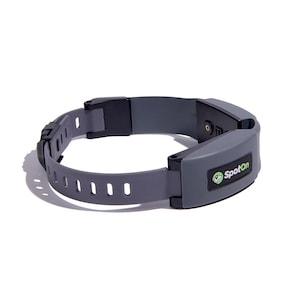
SpotOn Virtual Smart Fence
A GPS-style invisible fence that provides 1,000 acres of coverage and eliminates the need to bury wires.
- Customizable and Portable: Custom map your desired secure containment area’s shape and size, whether you’re at home or on the go.
- Large Range: Select a space from a half-acre to up to 1,000 acres.
- Reliable Accuracy: The SpotOn system uses three GPS networks for impeccable accuracy and consistency.
- Critical Alerts Provided: Receive notification alerts if your Houdini hound breaks the containment barrier — you can even track him from your phone.
- Free Connectivity at the Outset: Receive 60 days of free cellular service with your purchase, from that point, it is $6.95 per month (if you choose the tracking/connectivity option).
- Two Sets of Audible Tones: SpotOn is unique in that it uses two sets of tones before issuing an optional static correction.
- Non-Aversive Option: Offers the ability to completely turn off the static shock and just use tone warnings. SpotOn also provides a great non-aversive training plan for those who want to stick to positive reinforcement training.
- Made in the USA: SpotOn is designed and engineered in New Hampshire and assembled in the USA with domestic and foreign parts.
Pros
- Very easy to install — no digging required
- The system is portable
- The associated phone app provides a nice tracking and monitoring interface
- You can set the system to an audible-only (no-shock) correction
Cons
- It’s expensive
- Works much better for large areas than small areas
3. PetSafe Stay + Play Wireless Fence
About: The Stay + Play Wireless Fence from PetSafe is a model very similar to the unit mentioned above.
The major differences being that this unit has rechargeable collar units (rather than relying on batteries) and can emit a larger diameter.
This is a sponsored placement, in which an advertiser pays a fee to be featured in this article. Learn more
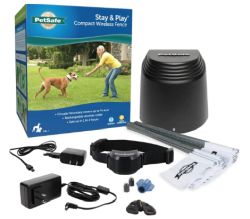
PetSafe Stay + Play
A wireless fence that provides up to 3/4 acres of coverage and features a rechargeable battery.
Key Features:
- Wireless & Easy: Simply turn on the transmitter unit, set your circular diameter range, and you’re done!
- More Space to Play: The Stay + Play unit can establish a circular containment area of ¾ acre (210 ft in diameter).
- Adjustable Correction Options: Choose from five different static correction levels or a sound only correction.
- Waterproof Collar: Features a waterproof receiver collar unit, so you needn’t come up with an alternative plan when it rains.
- Automatic Shut-Off: If your dog breaks through the boundary zone, the static correction will shut off after 15 seconds.
- Connect Multiple Yards: With multiple transmitters, you can connect several yards (or several other large areas) together for an extra large hidden dog fence.
- Portable System: Like the other wireless system discussed above, this unit is also portable, making it great for pet parents on the go.
- Suitable for Smaller Dogs: The unit can be used with dogs weighing 5 pound or more.
Pros
- No digging or wire installation necessary
- Portable — you can take it on the go
- Compatible with the original PetSafe wireless fence
- Waterproof receiver means it still works in the rain
Cons
- Some owners report that the boundaries aren’t as consistent as they were with the original PetSafe wireless unit
- May not work as well on hilly terrain
I also had the chance to try the Stay + Play Wireless Pet Fence.
When trying it out, I did indeed find that this unit seemed to yield a less consistent containment zone than the original model. When testing the boundary, the boundary line seemed to change minute to minute, moving in and out as much as 3 feet, and rarely beeping at the same point upon multiple tests.
4. PetSafe Basic In-Ground System
About: PetSafe also offers a wired, in-ground system that you can install yourself. Called the PetSafe Basic In-Ground Fence System, the wired nature of this product not only means that it is more affordable than most wireless options, it also means that you can layout the perfect area for your pet’s specific needs.
You will have to install this system yourself, but that’s just part of the trade off involved in such an affordable unit.
This is a sponsored placement, in which an advertiser pays a fee to be featured in this article. Learn more
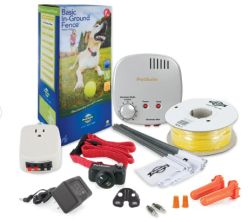
PetSafe In-Ground Electric Fence
An affordable in-ground fence that comes with 500 feet of wire, enabling you to design a custom space.
Key Product Features:
- Customize to Fit Your Yard: Underground wire means you can customize your boundaries for your property.
- 500 Feet Of Wire Included: This invisible dog fence unit comes with 500 feet of boundary wire, and is capable of being extended to cover up to 5 acres of land (with the purchase of additional wire).
- Adjustable Correction Options: Choose from several levels of correction, plus option for sound only correction.
- Waterproof: The hidden dog fence collar unit is waterproof, so no need to keep your dog inside when it’s raining.
- Automatic Shut-Off: If your dog does end up leaving the boundary zone, the static correction will shut off after 30 seconds. It won’t activate again for another 5 minutes.
- Suitable for Dogs Weighing 8 Pounds or More: This unit is suitable for dogs who weigh at least 8 pounds, and it is designed to fit necks that are 6 to 28 inches in circumference.
Pros
- You can customize the boundary area to suit your exact property
- Wired systems tend to establish more consistent boundaries
- Features several different correction options, including a tone-only mode
- Can provide a 500-acre play zone (with the purchase of additional wire)
Cons
- Installation is laborious and time consuming
- Repairing problems with the wire will be trying
PetSafe offers a different version of this in-ground kit for “stubborn” dogs over 30 pounds. They also offer an in-ground fence designed for small dogs (5 pounds or larger) and cats.
5. PetSafe YardMax Rechargeable System
About: The PetSafe YardMax Rechargeable In-Ground Fence is very similar to the PetSafe Basic In-Ground fence dicussed above. The major difference between the two is that the YardMax covers more area and provides 30% more usable yard space by moving the “warning zone” outside your boundary line.
This unit also features wireless collars and gives you the chance to set up “no-go zones” for indoor and outdoor objects you want to keep your pet away from.
This is a sponsored placement, in which an advertiser pays a fee to be featured in this article. Learn more
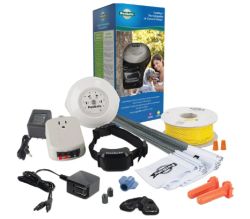
PetSafe YardMax Fence
An in-ground, wired unit that gives you the chance to provide your dog with additional space.
Key Features:
- Uses Wire to Suit Your Yard Shape: While units relying on underground wire can be a hassle to install, they allow you to create a perimeter that is customized to your yard size and shape. This unit comes with enough wire to cover a ½ acre, but can be expanded to establish containment zones as large as 10 acres (with additional wire).
- Warning Zone is Outside the Boundary Line: Since the warning zone lies past the boundary zone, rather than before it, your dog has more room to enjoy your yard. With other units, your dog can potentially break through the boundary zone. With this type of unit, your dog cannot break through the boundary and instead will continue to be corrected until he returns to the yard or 15 seconds passes.
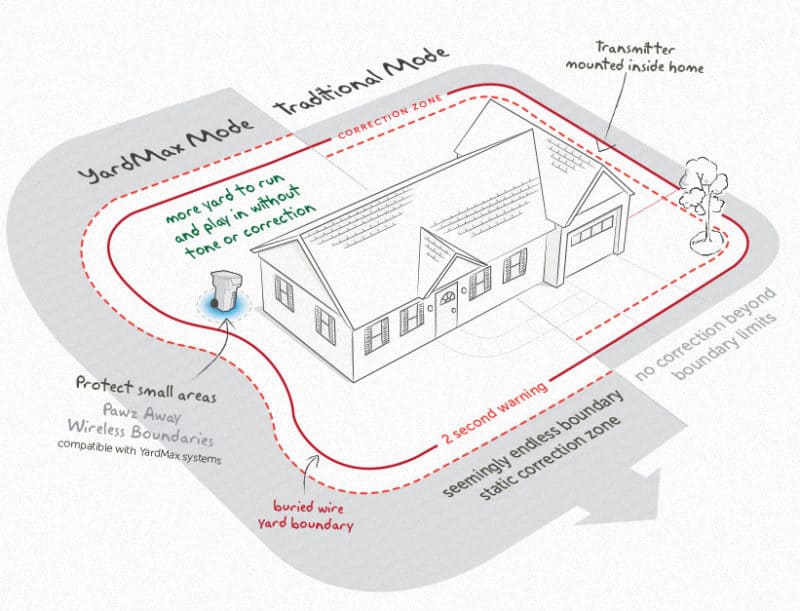
- Option to Create Extra Wireless Boundaries: With the YardMax unit, you have the option to create smaller wireless boundaries (referred to as Pawz Away barriers) around objects you don’t want your dog getting into (such as wells, trash cans, or sheds).
- Adjustable Correction Options: Choose from several levels of static correction or a sound-only mode.
- Waterproof, Rechargeable Collars: The collars included are rechargeable and waterproof.
- For Dogs Weighing 5 Pounds or More: This unit is suitable for dogs weighing 5 pounds or more, and it fits necks that are 6 to 28 inches in circumference.
- The More Pets, the Merrier: You can use as many collars as you want to this unit, making it great for multi-pet homes.
Pros
- The rechargeable batteries will save you money (and headaches) in the long run
- Capable of providing a very large (10-acre) containment zone (with purchase of additional wire)
- You can establish no-go zones for your dog
- Compatible with multiple collars
Cons
- As with all wired units, installation is a pain
- More expensive than classic in-ground and wired systems
Want a PetSafe underground wired dog fence but don’t want to install it yourself? You may want to check out PetSafe’s Pro Install option. Professionals will come install the unit and train your dog, doing all the work for you.
6. Invisible Fence: Traditional Containment
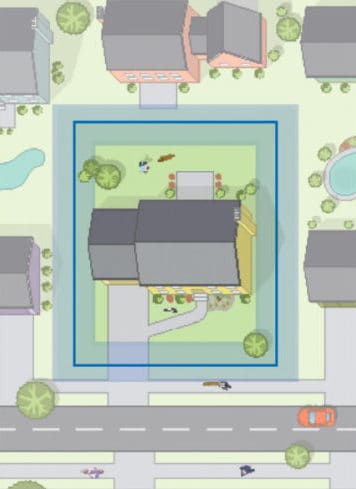
About: The Invisible Fence Pet Containment System features a physical wire that is installed around the boundaries of your property by a professional technician. This establishes the containment zone for your pooch.
A transmitter unit (usually placed in a garage or basement) will send a radio signal along the underground wire. The radio signal is then picked up by the corresponding collar unit.
The collar unit delivers a warning sound when your dog approaches the boundary. If the dog continues to approach the boundary after the warning, a static correction is issued.
This is a sponsored placement, in which an advertiser pays a fee to be featured in this article. Learn more

Invisible Fence Pet Containment System
A professionally installed, wired pet containment system that is customized to suit your yard.
Key Features:
- Underground Wire: A physical wire is installed underground surrounding your property’s perimeter.
- Professional Installation: An Invisible Fence professional will come and install the wire in your yard and set up your unit.
- Pet Training Assistance: Invisible Fence pet trainers will come and work with your pet to help him understand where he can and cannot go.
- Trusted Reputation: The Invisible Fence brand is a trusted and well-established invisible dog fence company with 40 years experience.
- Endorsed by the ASPCA and Veterinarians: The official Invisible Fence brand is endorsed by the ASPCA and many veterinarians.
Pros
- This is the most affordable option by the Invisible Fence brand
- Comes with professional installation and pet training
- Company has a track record stretching back more than 40 years
- Endorsed by the ASPCA
Cons
- Though this is the most affordable option from this brand, it is still pricey
- Comes with professional installation, but some owners may not enjoy having techs visit their house
- Only available via Invisible Fence
7. Invisible Fence GPS 2.0 Wireless Dog Fence

About: The Invisible Fence GPS 2.0 system is the most advanced of all pet containment systems.
To set it up, you’ll establish your yard boundaries via GPS satellite. Your dog then wears a special GPS computer collar to keep him out of the invisible boundary area.
This is a sponsored placement, in which an advertiser pays a fee to be featured in this article. Learn more

Invisible Fence GPS 2.0 Wireless Dog Fence
A professionally installed, GPS pet containment system that is designed for your yard.
Key Features:
- No Wires Are Involved: Instead of a physical underground wire, an Invisible Fence technician will come to your home and install the invisible dog fence GPS boundaries on your computer. Your pet wears a special GPS collar, which communicates with the main base computer.
- Warning Sound & Correction: As with most other systems, your dog will receive a warning sound and then a mild correction shock if he approaches a boundary.
- Complete Customization, Without Limits: With the GPS 2.0 unit, you can completely customize your yard boundaries, without the hassle of wire. There is no maximum size limit, giving you total control of boundaries.
- Works With All Terrains: While some other invisible fencing units cannot handle varied terrain or sloping yards, the GPS 2.0 fence works with all kinds of landscapes.
- Create Smaller No-Go Zones: This unit allows you to customize no-go zones (like pools, flower beds, or sheds) without add-ons or physical devices. It can all be accomplished via GPS.
Pros
- You can set up no-go zones inside your home
- Warning sounds occur before static corrections to help your dog better understand boundaries
- Will work with the brand’s collar-activated doggie doors
- Allows you to customize yard boundaries without the need for wire
Cons
- This is one of the most expensive options available
- GPS 2.0 doesn’t yet work in all areas
How to Train Your Dog With An Electric Pet Fence
When using an electric fence, it’s absolutely essential that you train your dog and teach him how the fence works.
Nearly all horror stories owners have with invisible fencing come as a result of not properly teaching their dog how the invisible fence works.
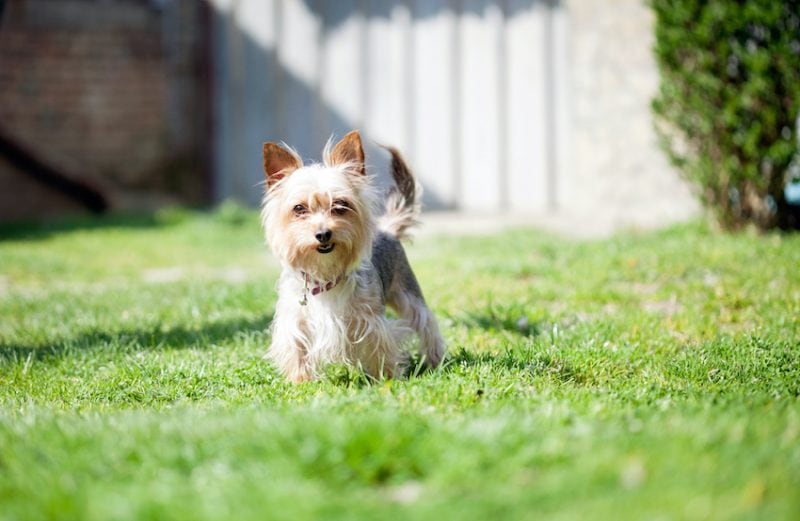
Setting up your electric dog fence and tossing your dog outside, hoping that he’ll figure it out how it all works, is a recipe for disaster.
Without training, dogs can’t understand why they are being shocked. In some cases, dogs become terrified to go outside or sit immobilized in their yard, too frightened to move.
Obviously this isn’t what any owner wants – the whole point of investing in an electric dog fence is to enable your dog to roam and frolic about the yard safely, not terrify him so much he becomes paralyzed with fear.
You’ll receive a collection of training information when you order your electric dog fence, but here’s a basic rundown of how it works.
- Set up the system and flags. After installing the dog fence system, you’ll set up visual flags around the perimeter of your boundary area 10-feet apart (you may need to buy extra flags for larger yards).
- Show your dog the boundaries using the tone only. Switch the collar to a tone-only setting and hold it in your hand. With your leashed dog, approach the flagged boundary line. When the collar emits the warning sound, bring your dog several paces back towards the safety area. Reward with praise and treats!
- Repeat the process, but add a few flags to the boundary. Repeat this process with a few flags on the first training day until your dog resists approach the flag.
- Start enabling the static correction. In following days, switch to the static shock correction (start with a low setting and adjust if necessary if your dog ignores it). Continue approaching the flags (and retreating after the correction) until your dog resists approach the boundary flags.
- Test your doggo by implementing tempting distractions. After several days of training, test your dog’s resolve by throwing a ball or toy outside of the boundary line. If he doesn’t go after the toy and stops at the boundary line, reinforce him with praise.
- Let your dog try the fence without his leash. After a week of solid training, let your dog off leash in the yard. Don’t move to this step until your dog has completed the previous steps.
- Begin to remove the flags. After two weeks, begin to remove boundary flags. Start by removing every other flag, and then eventually you can remove them all.
Extra Training Notes:
- Keep your training sessions short. Training sessions should last between 10 – 15 minutes. You don’t want to exhaust and frustrate your dog. Shorter, more frequent training sessions are the most effective.
- Keep things fun and incorporate plenty of play. Be sure to start and end every training session with plenty of fun play time. Take frequent play breaks if your dog seems stressed. Patience is key!
- Always remove your dog’s collar when leaving the yard. When going on outside walks, always remove the invisible dog fence collar and replace it with a walking collar and leash — you don’t want to shock your pupperino! Also, always leave by the same route when going for walks to avoid confusing your dog.
For more in-depth training help, YouTube has tons of helpful videos, such as this invisible fence training video from PetSafe.
Can I Install an Electric Dog Fence Myself?
The DIY route can be a hassle, but plenty of owners have installed in-ground wired systems themselves. If you feel confident, go for it.
Just read instructions carefully and make sure you have a map of your property. You don’t want to go digging around your yard and accidentally hit a water line or anything else potentially disastrous.
Setting up a wireless fence boundaries on your own is a breeze — it’s just a matter of plugging in the unit, placing the boundary flags in the appropriate areas, and starting the initial training for your dog.
Other Things To Keep in Mind With Electric Fences
A few other aspects to consider with hidden fences include:
- You may eventually need replacement collars. If your original collar breaks, you’ll need to buy a new one. Replacement collars can be quite expensive, ranging anywhere from $50 to $200.
- You can use many electric fences with multiple pets. Many units allow you to use your in-ground or wireless dog fence with multiple pets – you’ll just need to buy more collars.
- You’ll need to budget for replacement batteries. The battery life for collar units usually lasts around 3 to 4 months. Some replacement batteries are quite cheap – many units use simple watch batteries. However, that could end up costing you anywhere from $60 to $90 per year, so it’s certainly something to consider when budgeting.
- Use high-quality wiring. If you decide to go with an in-ground wired dog fence, you’ll want to pay particular attention to the gauge of wire you’ll be installing. When it comes to wiring, the lower the gauge, the tougher the wire. For this reason, we tend to recommend avoiding the 20 gauge wire that often comes with the lower-priced units. Instead, you are better off using 14 or 16 gauge wire, as it’ll last longer. Weaker 20 gauge wire will break more frequently, requiring you to dig up the wire and patch it. You can imagine what a headache that would be.
- You must prepare for power failures. Since invisible dog fences are powered by a electric transmitter units, power failures will shut down hidden dog fences. If you live in an area that frequently deals with power outages, a physical fence may be a better choice. We also recommend grabbing a surge protector to ensure that your transmitter unit doesn’t get destroyed in case of a power surge.
- Other animals can still get in. An in-ground or wireless dog fence will keep your dog in, but it won’t stop other dogs or animals from coming into the area (unlike traditional fencing, which keeps wildlife out while also containing your dog). This means that there is the possibility of your dog being attacked and being unable to escape the boundaries of your yard. For this reason, you should always supervise your dog when outside, even with the invisible dog fence installed.
- Electric fences can work for a variety of animals. While invisible fences are mostly designed with dogs in mind, many units can work with cats as well. Some people even use them with goats!
- Wireless electric fences work for camping and vacations. If you travel a lot or often go on camping vacations, you may be better off with the wireless units. The wireless units make it easy to transport and use your system in other areas. Just remember, you’ll need to re-train your dog and teach them where the new boundaries are.

- Be mindful of your dog’s age. It’s usually wise to avoid using an invisible dog fence until your pet is at least 6 months old. You want to wait until your dog is mature enough to be trained and can understand how to navigate the electric fence.
The Differences Between Wireless, In-Ground, and Physical Dog Fences: An Illustrated Guide
Here’s an illustration we created showing the differences between wireless, in-ground, and physical dog fences:

Are Electric Dog Fences Cruel? It’s Complicated…
Deciding whether electric dog fences are cruel or not is a tough nut to crack, and my thoughts on the issue have changed a lot over the years.
Initially, I would have told you that the small static shock correction issued by an electric fence is minimal and is similar to what you might experience if you rubbed your socks on a rug and touched a metal handle.
Used responsibly, most dogs will not be seriously traumatized by an invisible fence unit, with the static shock sensation being more “surprising” than physically painful.
However, as I have learned more about dog cognition and evidence-based training, my position has become less sure.
In truth, any tool that uses pain to control an animal (even what we might consider minimal pain) is not ideal. Aversive tools like shock collars use pain to control a dog’s behavior, which research has shown can increase stress levels, cause a dog to shut down, and potentially even result in increased aggression.
On the other hand, being able to let your dog roam in your yard can have a huge effect on your dog’s quality of life. And sometimes, electric hidden fences will be one of the only options for owners who are not allowed to put up a physical traditional fence due to HOAs or budgetary constraints.
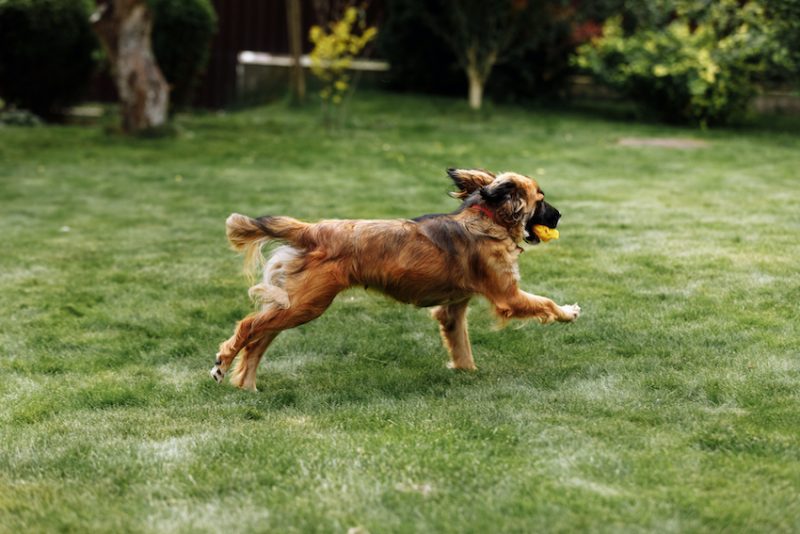
My family used an electric fence for my childhood dog Benzy, and it allowed him full access to our huge front and back yard.
I know having access to this outdoor space brought him great joy — I used to love watching him relax in the grass or sniff the air in delight, capturing some olfactory sensation I would never experience!
However, I also know Benzy was an anxious dog. He had separation anxiety early on when we got him (he had been with two previous families before us). He also displayed behaviors that I now recognize as indicative of great stress, such as excessive licking.
It breaks my heart to think I ever did anything that may have increased the stress and anxiety of my dear friend. I can’t help but wonder if it was the best choice, and in fact, I chose not to use an electric fence with my second dog.
Benzy learned his boundaries and rarely tested them after a month. In fact, after a few months we didn’t even bother putting the collar on him most times, as I felt comfortable that he understood where his yard boundaries were and wouldn’t cross them.
My second dog Remy is a rescue pittie mix. He was a confident cookie with plenty of “gameness”.
I ended up going with a physical barrier fence for Remy due to a few reasons.
- He has a high prey drive. Witnessing Remy’s high prey drive, I suspected he would be very likely to break out of the boundary to chase another animal.
- We live around many feral and outdoor cats. I have neighbors with outdoor cats, and knew there would be a high likelihood of Remy trying to chase down and potentially hurt a neighbor’s cat if he escaped.
- He’s a pit bull (mix) It’s a sad fact that many individuals have preconceived notions about pit mixes. If Remy got out and approached someone, they would be much more likely to be frightened and angry with me as opposed to a golden retriever escaping an electric fence.
- I wasn’t yet ready to completely trust him. When I first adopted Remy, I knew I needed a containment system ASAP. However, he was still a new dog with behavior issues I did not fully understand. Putting him in a situation where he could potentially escape and interact with other dogs and humans was high risk.
- Coyotes live in our area. Our house faces back to a large wooded area where we’ve spotted coyotes. One downside to electric fences is that they don’t keep out other animals. Of course I needed to avoid any situation where Remy could potentially interact with coyotes.
I also chose to go with a physical containment method because I began to question the ethics of electric hidden fences. I no longer feel confident that they are the best option.
4 Electric Fence Alternatives: Other Options
Shock fences aren’t your only option for containing your canine! Some alternatives include:
1. Boundary Training
Boundary training involves teaching your dog to stay within a set boundary with positive reinforcement.
- You’ll start out similar to how you would train a dog on an electric fence, setting up flags around your boundary.
- With your dog on leash, walk with your dog all around the inside of the boundary zone, clicking and treating all the while.
- Begin walking on the other side of the boundary while clicking and throwing treats to your dog as long as he stays inside of the boundary.
- Add difficulty by walking further outside of the bondary line, continuing to reinforce your dog for staying inside the boundary. Use a long line to keep your dog safe while allowing you to get more distance.
- If your dog breaks out of the boundary, run with him back into the boundary area and reward him for returning with you.
Kikopup offers a great instructional video on how to work on boundary training with your dog below:
Boundary training is fantastic because it teaches your dog to stay inside the boundaries without using pain or fear. However, it requires a ton of practice and proofing with a variety of situations.
Still, if you want fence-free freedom that doesn’t use force, this is your best option.
2. Tie Outs or Trolleys
Trolleys and tie outs are other options for canine containment. Tie outs function by embedding a stake into the ground and connecting a line from your dog’s collar or harness to the stake.
This allows your dog to move freely within a set radius as far as the lead line allows.
However, tie-outs can tangle up with your dog easily, and your dog can seriously injure his throat pulling on the line. Even with a tie out stake, you’ll want to do some training to teach your dog not to pull on the stake and to stay in his perimeter.
Trolleys operate in a similar manner, but instead of a stationary stake, your dog’s line is attached to a trolley system that operates like a zip line, allowing your dog more freedom of movement and access to more space.
The video shows a quick and easy setup for a trolley system:
You should never leave your dog unattended outside with any of the methods described, but this is doubly true for tie-outs and trolleys due to their potential for choking.
3. Invisible Fence With Sound-Only Mode
Another option for pet owners who aren’t comfortable with shocking their dogs is using the sound-only mode with an invisible fence unit. This is a safer, more humane approach to boundary training that still takes advantage of some great electric training products.
The SpotOn Fence is especially great for this since it has an easy option to turn off the static shock and also offers two sets of different auditory warnings with an alert tone and a warning tone as your dog nears the invisible boundary area.
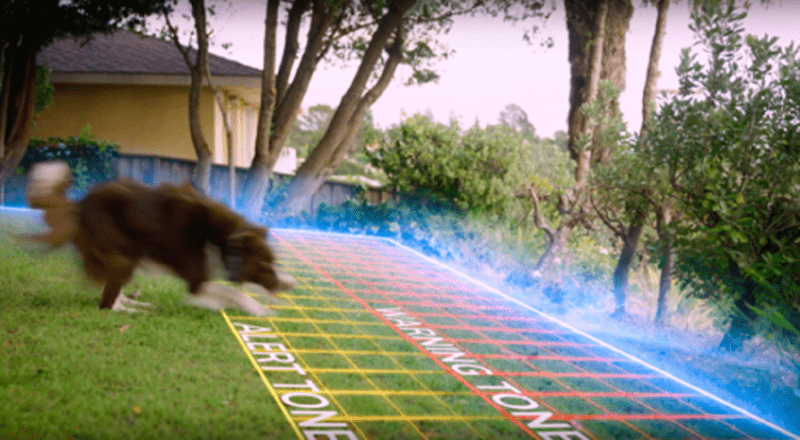
SpotOn even offers a great non-aversive training plan you can use that relies on positive reinforcement boundary training.
4. Install a Cheap DIY Fence
If you can’t afford a traditional fence, you may be able to put together a budget-friendly DIY dog fence for under a few hundred dollars.
This is ultimately what we ended up doing for my second dog Remy. Using cheap welded wire fencing and T-posts, I was able to make a suitable containment fence for Remy with a couple days of work for less than $200.
***
Do you have experience with using under ground or wireless dog fences? Share your experience in the comments!
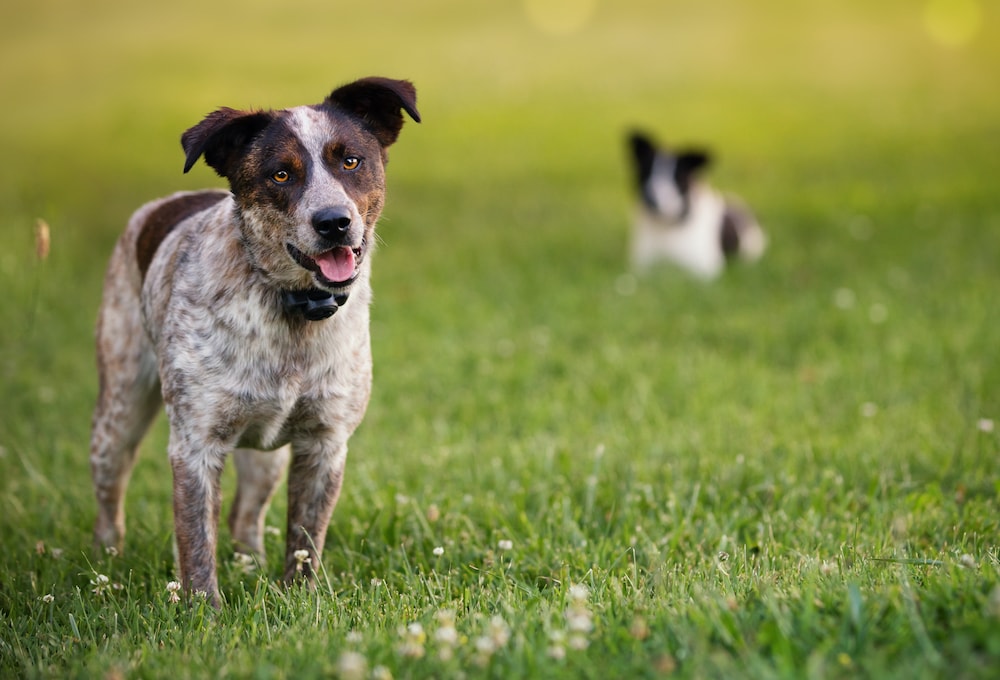

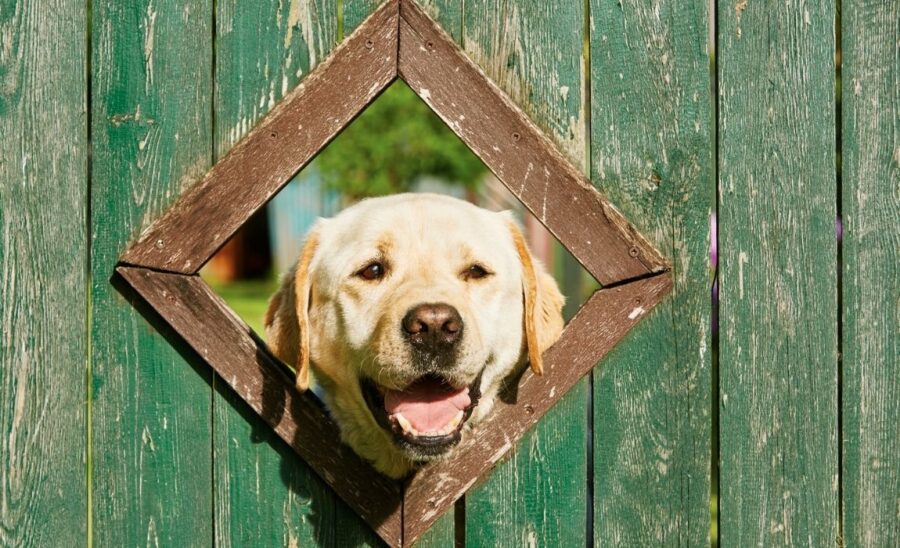



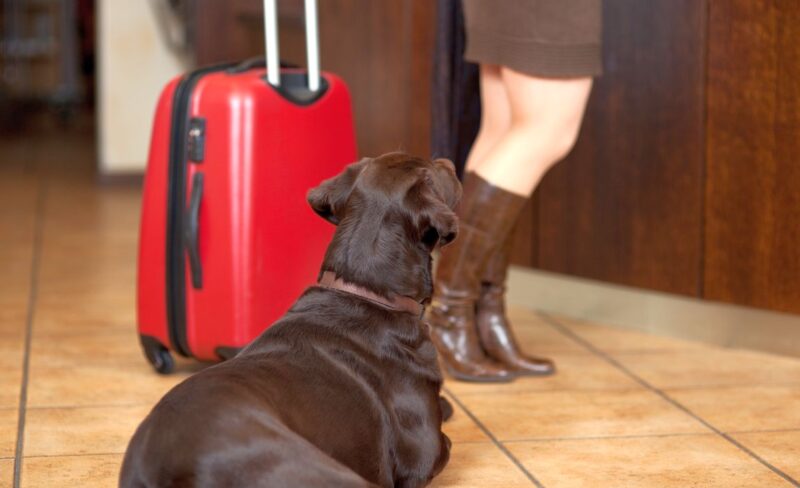
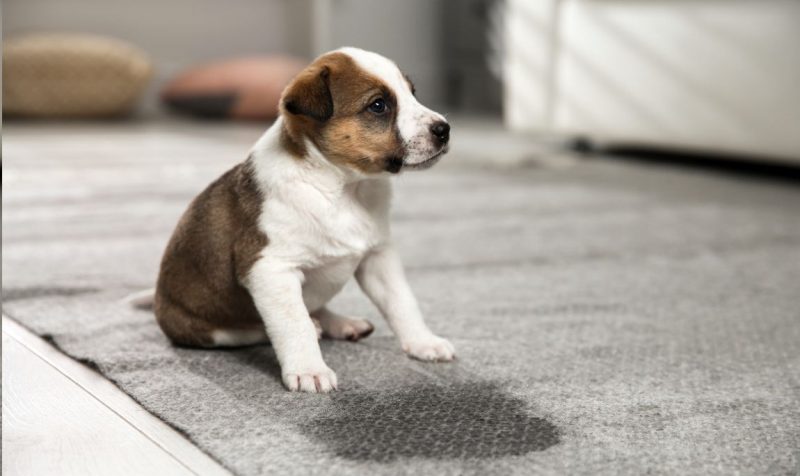

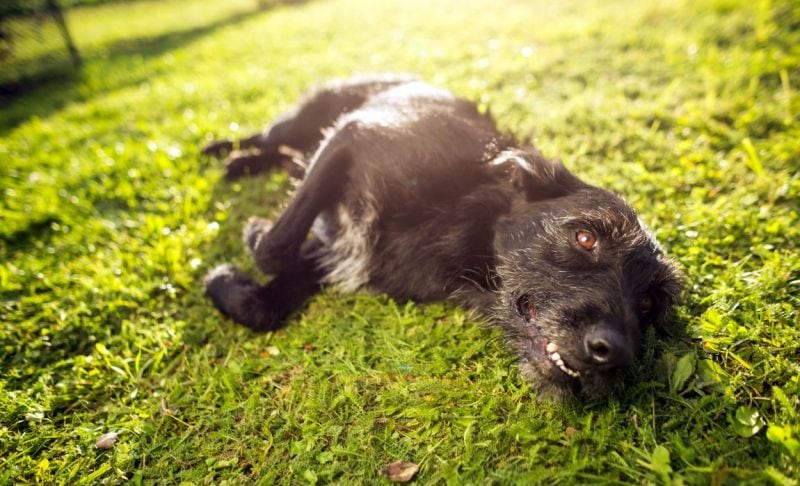

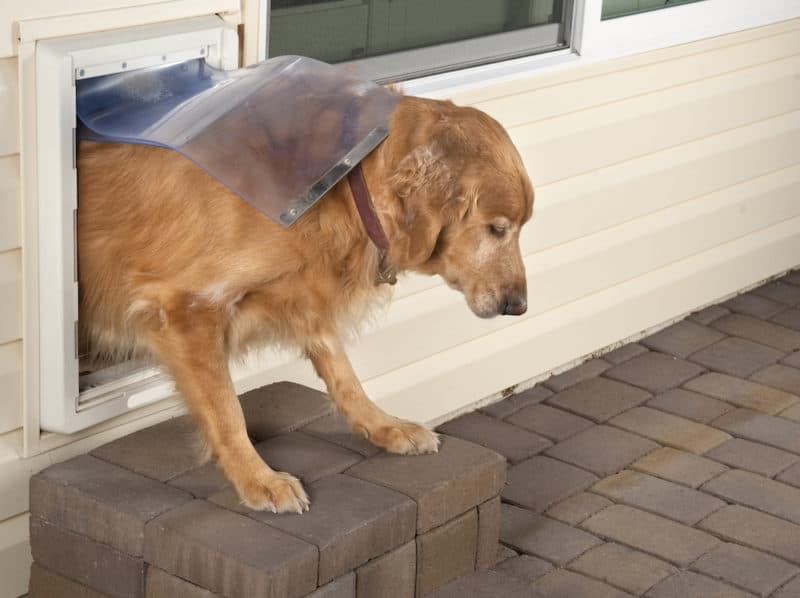

Leave a Comment